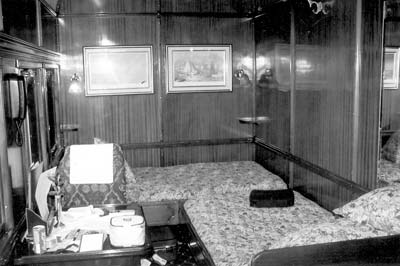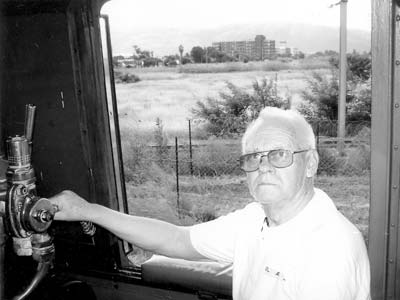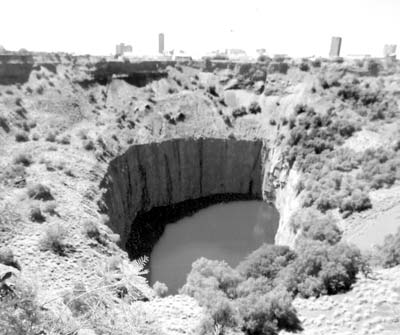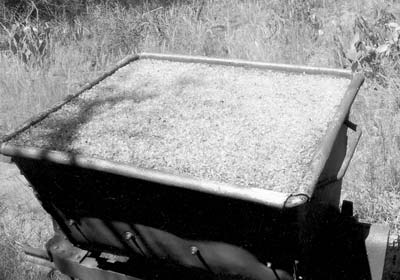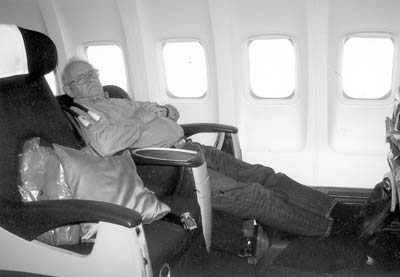The most luxurious train in the world
(Second of three parts, jump to part 1, part 2, part 3)
The luxury train
Of the world’s few “luxury trains,” two are in South Africa and they follow similar itineraries. The Blue Train promises the pleasures of a modern 5-star hotel. In contrast, Rovos Rail claims to run the “most luxurious train in the world,” with restored pre-war antique engines and passenger cars and more leisurely itineraries. This report is on a Rovos Rail trip I took in March 2005.
Rovos Rail’s private station in Pretoria is on a 25-acre site where there is plenty of space for a small museum, for a 1920s-style waiting room and for a display of classic steam engines and other rolling stock.
Although services for steam engines are increasingly unavailable for long trips, every effort is made to have each arriving and departing train from Pretoria pulled by a steam engine. Most of the mileage of a trip utilizes diesel and electric locomotives.
On Rovos Rail excursions, a maximum of 72 passengers are accommodated, staying in fully air-conditioned train suites that are the most spacious in the world. One standard railroad passenger car on most trains carries some 30 to 50 travelers. For standard suites on Rovos Rail trains, an entire railroad car has only three rooms, providing accommodation for a total of three travelers (or six traveling double)! In these standard suites, full king-sized beds are available.
There are only four Royal Suites, two each in specially designed passenger cars. These extra-deluxe rooms have en suite bathrooms and showers (and heated towel racks), the same as in standard suites, but are larger and have a claw-foot Victorian bathtub and a private lounge area.
A variety of Rovos Rail itineraries includes leisurely stops at points of interest, such as game reserves with 3-day safaris in the heart of the African bush, or Victoria Falls.
The owner of Rovos Rail, Rohan Vos (hence the name “Ro Vos” Rail), established “The Pride of Africa” service in 1986. He scoured the countryside of Africa looking for old coaches and locomotives that could be restored. What started out as an expensive hobby developed into regularly scheduled luxury service. Rohan Vos endeavors to personally meet every arrival and departure from Pretoria.
Improvised adventure
At the Pretoria station, while the rest of the passengers were in the waiting room being briefed on the details of our upcoming adventure, I wandered out into the rail yard to see some of Rovos Rail’s 60 restored carriages and five operating steam engines (the oldest one was built in 1893).
After a look into the small museum of trains and planes (Rovos Rail offers itineraries which include flights on restored 1954-vintage propeller-driven Convair 440s), I watched a glistening, coal-fired locomotive being switched to a new location on the tracks. I called out to the engineer, “Could I come up into the engine?”
He answered, “Of course.”
I grabbed a handle and swung up onto the stairs and into the cab while it was moving down the track at a modest speed. For me, at age 75, this was the equivalent of any Indiana Jones stunt.
I missed the briefing lecture, but I felt that I had traded it for a mildly adventuresome 20 minutes. When the engine finished relocating, the engineer took my photo at the throttle before a guide came looking for her missing passenger.
Our departure was enhanced by a classical string duet and generous servings of champagne.
My very soft adventure
My 2-night journey from Pretoria to Cape Town on this Rovos Rail itinerary provided an insight into how “the other half” lives and travels. On this trip, the 39 passengers were pampered by a total of 18 staff members.
Semiformal attire is requested at dinner on board Rovos Rail. My suite attendant came by while I was unpacking. Without my asking, she offered to press my rumpled suit and a shirt for dinner.
There’s not much that you can pay for while on the train except for items from a modest memorabilia desk in the lounge car. All meals, drinks and services, including some laundry service, are provided without extra charge. The mini-bar in my suite was filled only after I had made some selections from a comprehensive list of teas, drinks and snacks.
Pauline, my attendant, gave me two extension numbers to call from the en suite phone in case I needed assistance any hour of the day or night. I enjoyed the gourmet meals in a marvelously restored, luxury 1920s dining car.
At the stops on my itinerary, champagne and snacks (of course) were served just before we reentered the train.
The cost of the 3-day/2-night Pretoria/Cape Town trip is approximately $1,400 per person, sharing. For other itineraries and prices, contact Rovos Rail, P.O. Box 2837, Pretoria 0001 Gauteng, South Africa; tel. 011/27-12/315 8242, fax 011/27-12/323-0843, e mail reservations@rovos.co.za or visit www.rovos.co.za.
The Kimberley diamond mine
My rail itinerary included a stop at the world-famous Kimberley diamond mine. A wonderful diamond mining museum is located right at the edge of the “big hole” where 14_ million carats were mined between 1871 and 1914. The mine (originally a small hill) is now pretty much filled with water, but it is still the largest man-made hole in the world. Diamond mining continues at other sites in the area around the city of Kimberley.
It’s a shame that this museum does not get more visitors; it’s said to be the most impressive museum in South Africa. The name of the Kimberley mine is widely known, and the topic — diamonds — is of great interest to all. Original buildings, working demonstrations of 19th-century mining equipment and old photos are on display at this historic site.
In the first few years of the “diamond rush,” up to 30,000 men worked tiny claims in crushingly crowded conditions in an area approximately the size of three football fields. Many became rich in the brief years of digging on individual claims. Over the 43-year period of mining at this diamond “pipe” (a volcano vent or chimney), an average area of digging measuring three feet by three feet by three feet (a cubic yard) yielded 10 carats of diamonds! The largest single diamond from this mine was the Star of Africa at 83.5 carats.
Previous to 1867 when diamonds were first discovered in South Africa, they came almost exclusively from India and Ceylon, with sources and origins clouded in mystery. When the De Beers Consolidated Diamond Mines Company managed to get control of the entire Kimberley mine in 1888, a diamond monopoly was born.
Incidentally, the weight standard of “carat” for diamonds came from the weight of one seed of the carob tree, which is common in South Africa.
SWISS all-business-class flights
Air service for my March 2005 trip was provided by Swiss International Air Lines (SWISS). The leg from Newark, New Jersey, to Zürich was on one of their new (as of January 2005) all-business-class flights on a Boeing B737-800 with only 56 seats (an Airbus A340, by comparison, has 228 seats).
The seats are “lie-flat,” with 60 inches between rows. The seats do not go to perfectly horizontal but at a 9-degree angle to the floor are laid back enough to provide comfortable sleep. With four cabin attendants on duty, it was the next-best thing to flying on a large private jet. For more information, visit www.swiss.com.
The complimentary travel arrangements, the accommodations and a tour director for me and a small group of travel writers on this trip were supplied by KAI, or Kartagener Associates, Inc., a full-service travel and marketing firm based in New York City.
Happy trails!


